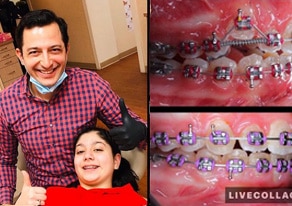Hidden (Lingual) Braces in Brooklyn NY
Lingual braces offer a discreet way to straighten teeth by placing the braces on the back side of the teeth, making them virtually invisible from the front. This treatment is ideal for those seeking effective orthodontic care without the noticeable appearance of traditional braces.
What are Lingual Braces?
Lingual braces are a type of orthodontic treatment where the braces are placed on the back side of the teeth, making them virtually invisible from the front. Unlike traditional braces that are attached to the front of the teeth, lingual braces are hidden from view, offering a discreet option for those seeking orthodontic treatment.
Traditional braces use metal brackets and wires placed on the front of the teeth to straighten them. In contrast, lingual braces use the same brackets and wires but position them on the back side of the teeth. This placement makes them less noticeable while still effectively correcting dental issues such as misalignment, gaps, and bite problems.
How Do Lingual Braces Work?
Initial Consultation and Customization
Lingual braces work by applying pressure to the teeth from the back side, gradually moving them into the desired position. The orthodontist begins by taking an impression of your teeth, which is used to create customized brackets and wires specifically designed for your dental structure.
The customization process ensures that each bracket fits perfectly on the back side of your teeth, making the treatment more effective and comfortable.
Fitting the Braces
Once the custom braces are ready, the orthodontist bonds the brackets to the back side of your teeth and connects them with wires. This placement ensures that the braces remain hidden from view, offering a discreet treatment option.
Regular Adjustments
During the treatment, regular adjustments are necessary to keep the teeth moving in the right direction. The orthodontist tightens the wires periodically, ensuring consistent pressure on the teeth to guide them into the correct alignment. This process continues until your teeth reach their final, straightened position.
Lingual braces offer the advantage of being hidden from view, providing a more aesthetic option for orthodontic treatment without compromising effectiveness.
Benefits of Lingual Braces
Aesthetic Advantages
Lingual braces are nearly invisible since they are placed on the back side of your teeth. This makes them an excellent choice for anyone concerned about the appearance of traditional braces.
Suitability for Various Dental Issues
Lingual braces effectively address a wide range of dental problems, including misalignment, gaps, and bite issues. They provide the same corrective benefits as traditional braces while remaining hidden.
Comfort and Convenience
Lingual braces are custom-made to fit the unique shape of your teeth, enhancing comfort. Although they may require an adjustment period, most patients find them convenient for daily life, with fewer visible impacts on their smiles.
Ideal Candidates for Lingual Braces
Age Groups and Dental Conditions
Lingual braces are suitable for both teenagers and adults. They work well for individuals who need orthodontic treatment but prefer a less noticeable option.
Assessment by Orthodontists
Orthodontists assess several factors to determine if lingual braces are the right choice. They consider the complexity of your dental issues, your overall oral health, and your personal preferences. After a thorough evaluation, the orthodontist will recommend the best treatment plan tailored to your needs.
Treatment Process
Initial Consultation and Evaluation
During the initial consultation, the orthodontist examines your teeth and discusses your treatment goals. They take impressions or digital scans to create custom brackets that fit the back side of your teeth.
Fitting and Adjustments
Once the custom braces are ready, the orthodontist bonds the brackets to the back side of your teeth and connects them with wires. Regular adjustments are necessary to keep the teeth moving in the right direction. These appointments typically occur every 6 to 8 weeks.
Duration and Follow-Up Appointments
The duration of treatment varies depending on the severity of your dental issues, but most patients wear lingual braces for 18 to 36 months. Follow-up appointments ensure that the treatment progresses as planned and address any concerns.
Comparing Lingual Braces to Other Orthodontic Options
Traditional Metal Braces
Traditional metal braces are the most common type of orthodontic treatment. They use metal brackets and wires on the front of the teeth to correct alignment. While effective, they are more visible than lingual braces.
Invisalign and Clear Aligners
Invisalign and clear aligners use a series of clear, removable trays to straighten teeth. They offer a nearly invisible appearance but are less effective for severe dental issues compared to lingual braces.
Ceramic Braces
Ceramic braces function similarly to traditional metal braces but use tooth-colored or clear brackets that blend with your teeth. They are less noticeable than metal braces but still more visible than lingual braces.
Why Choose Halabi Orthodontics for Lingual Braces?
At Halabi Orthodontics, we prioritize your comfort and satisfaction throughout your orthodontic journey. Our team, led by Dr. Halabi, offers expert care and personalized treatment plans tailored to meet your specific needs. Here’s why you should choose us:
Expert Care
Dr. Halabi is a skilled orthodontist with extensive experience in providing top-quality orthodontic treatments. Our team stays updated with the latest advancements in orthodontics to ensure you receive the best care possible.
Choose Halabi Orthodontics for a confident, beautiful smile. Schedule your consultation today and experience the difference expert orthodontic care can make.
Frequently Asked Questions (FAQs)
What are lingual braces?
Lingual braces are orthodontic devices placed on the back side of the teeth, making them nearly invisible from the front. They function like traditional braces but are hidden from view.
How do lingual braces differ from traditional braces?
Unlike traditional braces, which are attached to the front of the teeth, lingual braces are bonded to the back. This placement makes them less noticeable while still effectively straightening teeth.
Are lingual braces suitable for everyone?
Lingual braces are suitable for both teenagers and adults who prefer a discreet orthodontic option. Your orthodontist will evaluate your dental condition to determine if they are the right choice for you.
How long does the treatment with lingual braces take?
The duration of treatment varies based on individual dental needs but typically ranges from 18 to 36 months. Your orthodontist will provide a more accurate timeline during your consultation.
Are lingual braces uncomfortable?
There may be an adjustment period as your tongue gets used to the braces, but most patients find them comfortable after this initial phase. Customization ensures a better fit and enhances comfort.

 CURRENT PATIENT NUMBER
CURRENT PATIENT NUMBER

 What patients are saying
What patients are saying Your smile our passion
Your smile our passion News and Events
News and Events